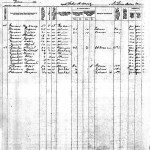Genealogy Records 101
A Military Records Search Strategy for Your Family Tree
November 11, 2011 by ramona
Filed under Articles, Genealogy Military Records, Genealogy Records 101, Public Records
 Having an ancestor who served in the military is a source of pride for many families and justly so, making military genealogy a popular avenue of research. Who would not want to delve into the details of their forebear’s military service in order to honor these family heroes? Finding the details of their service however, can be a challenging prospect, especially when it comes to more recent records. To make matters more confusing, the sheer number of online databases can be overwhelming to the genealogy beginner; making it difficult to know where to begin.
Having an ancestor who served in the military is a source of pride for many families and justly so, making military genealogy a popular avenue of research. Who would not want to delve into the details of their forebear’s military service in order to honor these family heroes? Finding the details of their service however, can be a challenging prospect, especially when it comes to more recent records. To make matters more confusing, the sheer number of online databases can be overwhelming to the genealogy beginner; making it difficult to know where to begin.
Having a good step by step strategy for your research will undoubtedly help uncover your predecessors courageous past.
The first step: start with what you know
Your search for military documents is no different than any other type of genealogy research, in that, the first step of any ancestor hunt is starting with what you know. Do you or another family member have any military memorabilia such as discharge papers, medals, photographs, weapons or even uniforms? If so, that is clearly the place to start. Any and all of these things can provide valuable information to help set you on your way to recovering more records needed to put new buds on your family tree.
The second step: focus on your target
Decide on your target. What do you want to find first. This may include educating yourself on the many types of military records available. It is important to know what records you are looking for, before you can start searching for them. Also, note that records may differ for the time frame you are searching, be it the war of 1812, the Civil War or World War II. In addition, the branch of military your family member served in Army, Navy or Coastguard etc, will have some bearing on your search strategy. For instance during the second world record types include:
- World War 2 Personnel Files
- World War 2 Military Unit and Ship Records
- Merchant Marine Records
- Army Enlistment Records
- Draft Records
- World War 2 POW Records
- World War 2 Casualties
- Cadet Nurse Corps
- Internment and Relocation Records
- Civilian Participation at Home
The most important of these records for the beginning genealogist is the record of discharge or “Report of Separation” which is kept in the personnel files. A Report of Separation is generally a one page document that contains all of the information concerning your ancestor’s service such as rank, dates of service, service number, unit, battles and campaigns as well as any decorations and awards received.
Step three: identify your resources
Online
Online genealogy sites are fast becoming the main resource for genealogists researching military records. With the advent of digitized records they are available from both subscription sites as well as archival collections held by government agencies. Whether you choose to use a paid resource, which is quite often more convenient and often gives faster results due to their searchable databases, or conduct a manual search of archived records, may depend on the time and money you have to spend. One of the more prominent online sites for military genealogy is Fold3.com. Formerly Footnote.com, Fold3 is owned by the same company as ancestry.com. The company has decided to use Fold3 exclusively as a site for searching military records.
Government archives are your best pick if you are working within a budget from your home computer and have the time to conduct a manual search. It is important to note that not all government archives have available records online; the availability of records can vary with the country you are searching. As a last word and this can be important to your genealogy budget, before you pay for a subscription, check with your local library. Many libraries (both local and university libraries) have free in-library access to ancestry.com.
Hard Copy
Hard copy records are a resource that should never be overlooked. Searching for hard copy records requires a little footwork but can present a huge pay-off; the main source for these record types includes state and provincial archives. It also pays to check with historical and genealogical societies as they frequently have military record collections. One last resource that bears mentioning is newspaper archives held by most libraries on microfilm. Local newspapers are rich with family history information as they often contain stories of departing and arriving local soldiers, in addition you may also find mentions of a soldier’s letter home.
Final Step: analyze your findings
Once you have collected the records you have set out to find, analyze them closely as they may lead you to your next search target. For example, a copy of your great grandfather WWII discharge papers will tell you of any awards or honors he received. This may lead to questions about why, when and how he received them. If a Purple Heart Medal is listed, this tells you he was wounded or killed in service, a Silver Star indicates valor in the face of the enemy. This certainly enriches your family history in addition to helping you understand what kind of person he was.
A good genealogy community can be a great boon in helping to sort out what you need to know in order to make a strong start. If you need some help in this area, join us on the Discovery Panel forums for further discussions on military records
US Social Security Office for Genealogy
January 26, 2010 by Chris
Filed under Articles, Genealogy Civil Records, Genealogy Records 101, Public Records
 Did you know that any United States citizen living in the US on or after 1936 is required by law to have obtained a Social Security Card. A Social Security Card is obtained by filing a Social Security Application. Social Security Applications are a part of the public record. The Social Security Application requires the applicant to state their mother’s and father’s full name. Very helpful to someone researching their family tree. To get access to these public records, you need to visit the Social Security Administration or a site that allows you to search their records.
Did you know that any United States citizen living in the US on or after 1936 is required by law to have obtained a Social Security Card. A Social Security Card is obtained by filing a Social Security Application. Social Security Applications are a part of the public record. The Social Security Application requires the applicant to state their mother’s and father’s full name. Very helpful to someone researching their family tree. To get access to these public records, you need to visit the Social Security Administration or a site that allows you to search their records.
You can search the records of the US Social Security Office from a number of sources. One popular source is at RootsWeb (which you can visit at the link below).
What To Ask The Crypt Keeper – Genealogy Research at Graveyards
November 7, 2009 by Chris
Filed under Articles, Cemetery Searches, Genealogy Cemetery Searches, Genealogy Records 101
 Some people have asked me about gravestone photos. We received a couple of emails on that, so I thought it would be helpful to write a little about the role of graveyards in your genealogy research. They are critical! As you get your hands on death certificates or even learn more about where your ancestors lived, you’ll be able to consult the local graveyards to find information on spouses, birth dates, and other family members. Keep in mind that in many cases, families are buried together (sometimes for several generations). This was truer for our ancestors than it is for us today. People didn’t travel as they do today.
Some people have asked me about gravestone photos. We received a couple of emails on that, so I thought it would be helpful to write a little about the role of graveyards in your genealogy research. They are critical! As you get your hands on death certificates or even learn more about where your ancestors lived, you’ll be able to consult the local graveyards to find information on spouses, birth dates, and other family members. Keep in mind that in many cases, families are buried together (sometimes for several generations). This was truer for our ancestors than it is for us today. People didn’t travel as they do today.
Our past generations tended to live in the same area. This makes graveyards a great resource. Also remember that many graveyards are denomination specific. Don’t waste time looking for a Catholic ancestor in a Protestant graveyard.
Accessing Military Records
March 8, 2009 by Chris
Filed under Articles, Genealogy Military Records, Genealogy Records 101, General Tips
 The following came from a current subscriber to Genealogy Beginner.
The following came from a current subscriber to Genealogy Beginner.
“Great advice: First I would like to let you know I enjoy your tips. As a beginner they have been very helpful. I know different states have laws in reference to military records. In the state of South Carolina military records are not public. The information can only be given to the individual, their Power of Attorney, or spouse. The SC state statute is very clear and states that the military records can only be used for genealogical research 50 years after the death of the person whose military records are referenced. I know this to be a fact because I work in the office where the military records are recorded in Aiken County, South Carolina.”
We have to be very cautious as to who has access to these documents.
Where to Next? Blank Family Tree Template
Genealogy Trees | The Role of Cemeteries
December 31, 2008 by Chris
Filed under Articles, Cemetery Searches, Genealogy Cemetery Searches, Genealogy Records 101
 As regular readers of this site you know I’m a big fan of making sure cemetery research is a method used for researching your genealogy and family trees. Below is an example from Southern Graves (see link below for original post) on how we can find our past generations using cemetery search methods.
As regular readers of this site you know I’m a big fan of making sure cemetery research is a method used for researching your genealogy and family trees. Below is an example from Southern Graves (see link below for original post) on how we can find our past generations using cemetery search methods.
The author of the original post writes…
Mrs. Eliza B. R. Mendenhall died almost 160 years ago on December 29, 1848. She was 67 years of age at the time of her death, so her birth year was about 1781. She, along with her infant grandson John Bruce Limehouse, was interred in St. Philip’s Church Cemetery; Charleston, South Carolina.
I love the wording on this stone. In case you cannot read it via the photo, here is a transcription:
This marble marks the spot where repose
the remains of
Mrs. Eliza B. R. Mendenhall,
Who closed her earthly career on the 29th December A.D. 1848,
aged 67 years.
By her side sleeps her infant
grandson
John Bruce Limehouse.
“Thou art gone to the grave, but we will
not deplore thee
whose God was thy ransom, they Guardian
and Guide.
He gave thee, He took thee
and He will restore thee,
and death has no sting for the
Savior hath died.”
This stone is consecrated
to a beloved mother
by her daughter.
(This posting is from Southern Graves. Click the link to view the full article from its original source.)
As you can see from the transcription, there is a wealth of information to help us complete our family trees. Grave stones typically contain extensive records of birth and death dates. They also often cite family members.
By doing the math on age and date of death you can get the date of birth. While not cited here, you sometimes can discover where someone lived from a grave stone as well, which can lead to a local government office and a copy of a birth certificate (which, as you know, will reveal the parents and thus the next generation.)
Don’t overlook cemeteries in our work to build out your genealogy trees. They will save you a ton of time.
…
Where to Next?
Blank Family Tree with Step-by-Step Instructions
…
How to Do a Family Tree – Update on New Resource
December 30, 2008 by Chris
Filed under Blank Family Tree, Family Search The LDS, Genealogy Records 101
 The Family Search website has added over 15 million new indexed records to its Record Search pilot, all from the 1850 and 1870 U.S. Censuses. The records are linked to the digital images of the originals. The new records can be searched for free at FamilySearch.org (Click Search Records, then Record Search pilot).
The Family Search website has added over 15 million new indexed records to its Record Search pilot, all from the 1850 and 1870 U.S. Censuses. The records are linked to the digital images of the originals. The new records can be searched for free at FamilySearch.org (Click Search Records, then Record Search pilot).
Chris
Scotland’s Greatest Story: www.ScotlandsGreatestStory.co.uk
Professional family history research & genealogical problem solving
(This posting is from Scottish Genealogy News and Events. Click the link to view the full article from its original source.)
…
Where to Next?
…
Making A Family Tree – Graveyard Rabbits
December 11, 2008 by Chris
Filed under Articles, Cemetery Searches, Genealogy Cemetery Searches, Genealogy Records 101
 Making a family tree is never an easy undertaking. There are a lot of things to figure out and organize. However, regardless of where you are in the process of making your family tree you’ll find that knowing a bit about researching graveyards will make a huge difference. Today, I’d like to reference the works -as I’ve done often before – of Southern Graves who provides a great little story about the Graveyard Rabbit that I’m sure you’ll enjoy.
Making a family tree is never an easy undertaking. There are a lot of things to figure out and organize. However, regardless of where you are in the process of making your family tree you’ll find that knowing a bit about researching graveyards will make a huge difference. Today, I’d like to reference the works -as I’ve done often before – of Southern Graves who provides a great little story about the Graveyard Rabbit that I’m sure you’ll enjoy.
By way of introduction, the author writes:
My nickname in high school was “squirrel,” but it turns out I am really a rabbit. A Graveyard Rabbit, that is.
If you haven’t noticed the new statement in the heading, I am a charter member of The Association of Graveyard Rabbits. This group was founded by Terry Thornton, and she writes all about the name at her new The Graveyard Rabbit of the Hill Country blog. The short of it is the name came from a poem entitled The Graveyard Rabbit by Frank Lebby Stanton. My favorite lines of the poem are in the very beginning.
In the white moonlight, where the willow waves,
He halfway gallops among the graves –
A tiny ghost in the gloom and gleam,
content to dwell where the dead men dream…
This definitely describes my passion for cemeteries and the histories they share. Let’s break it down:
“In the white moonlight, where the willow waves”
I don’t visit cemeteries at night too much, only because it’s hard to read the stones and take pictures then! However, there are often live willows waving when I visit, as well as many stone willows standing tall.
“He halfway gallops among the graves”
At the risk of sounding silly, if I’m at a Cemetery I’ve never visited before, I often do the same thing! I go from stone to stone, in no kind of pattern, just to get a feel of the place. Plus, an interesting monument from afar gets my interest and I must check it out. I have to make myself at some point stop and systematically go through the graves for proper transcription, photographs, and to begin to get the full history of the Cemetery and those interred.
“A tiny ghost in the gloom and gleam”
I and my visit are but a tiny speck of the whole history of most cemeteries. Especially those that have been around for hundreds of years. There have been many visitors before me, and there will be many after me.
“Content to dwell where the dead men dream”
That statement is a simple fact that applies to me. I am very content walking among the headstones, reading them, photographing them, and learning from them.
I hope you will continue to join me on my journey through the cemeteries of the southern United States at the Southern Graves site and this Southern Graves blog.
Really great stuff, wouldn’t you agree? This is the type of story that makes genealogy and family history research so much fun. Sure, there is the process of hunting down certificates, finding dates and dealing with name changes but then there is also the rich history of the past written in stone. Grave Yard Rabbits are truly a wonderful group who I’m sure we will be revisiting in the future.
(This posting is from Southern Graves.)
…
Where to Next?
…
St. Andrew’s Cemetery; Darien, Georgia
September 17, 2008 by Chris
Filed under Articles, Cemetery Searches, Genealogy Cemetery Searches, Genealogy Records 101
 The poetic inscription at the beginning of this article about St. Andrew’s Church Cemetery in Darien, McIntosh County, Georgia, reads:
The poetic inscription at the beginning of this article about St. Andrew’s Church Cemetery in Darien, McIntosh County, Georgia, reads:
“At the end of this avenue, on high land overlooking the creeks and marshes, Thomas Spalding of Sapelo established his family burial ground.”
This short article is part of the Historical Marker Database recently uploaded from Southern Graves, a website dedicated to the history, research and preservation of Southern U.S. cemeteries and burial sites large and small.
The site contains Southern cemetery listings, directories, and a broad and wondrous selection of articles; from the humorous to the heartfelt and beyond. The site also contains a link to a remarkable must read Blog filled with winning and always interesting subject matter.
This site is not only a treasure to genealogists but should be commended for the spirit in which it is presented, respectful, yet full of the human experience.
A must read for all! Beautifully done!
I highly recommend a visit to Southern Graves Home.
…
Where to Next?
…
Facebook for the Dead?
September 11, 2008 by Chris
Filed under Articles, Cemetery Searches, Genealogy Cemetery Searches, Genealogy Records 101
A press release from  explains how, and why, Footnote.com takes social networking into the past. When a loved one is lost, friends and family members experience a range of emotions from sorrow and grief to comfort. Often, this leads to sharing stories and memories. Until now, it has been a challenge to find a place where these stories can come together to easily be shared, preserved and enriched. At Footnote.com, anyone can create or find Footnote Pages, a space where users can connect and share information, photos and stories about people important to them.
explains how, and why, Footnote.com takes social networking into the past. When a loved one is lost, friends and family members experience a range of emotions from sorrow and grief to comfort. Often, this leads to sharing stories and memories. Until now, it has been a challenge to find a place where these stories can come together to easily be shared, preserved and enriched. At Footnote.com, anyone can create or find Footnote Pages, a space where users can connect and share information, photos and stories about people important to them.
To celebrate the new Footnote Pages, Footnote.com created over 80 million pages from the data in the SSDI. These pages feature an interactive timeline, map, photo gallery, and many other tools which has led some to refer to Footnote Pages as the Facebook for the Deceased.
Read the full press release at the Footnote Press Room, or visit the Footnote Blog.
…
Where to Next?
…
The Handloom Weavers of Perth website
September 11, 2008 by Chris
Filed under Blank Family Tree, Genealogy Occupational Records, Genealogy Records 101
 Genealogy is an ever fascinating subject and you may be surprised at just how many research approaches are available to you. We are all informed about the primary concepts of – start with you and hunt the down those birth, marriage and death records. Very soon after that, avid researchers are busily tracking down the most likely census returns. However, were you aware that you may be missing out on another incredibly valuable but often overlooked resource in researching your ancestor’s; researching their trade?
Genealogy is an ever fascinating subject and you may be surprised at just how many research approaches are available to you. We are all informed about the primary concepts of – start with you and hunt the down those birth, marriage and death records. Very soon after that, avid researchers are busily tracking down the most likely census returns. However, were you aware that you may be missing out on another incredibly valuable but often overlooked resource in researching your ancestor’s; researching their trade?
On many of the above mentioned records you will likely find the profession or trade of your past generations listed along with all of the vital statistics data. From this point on you can begin your journey down an amazing path of discovery, which will not only provide you with more factual information but more importantly bring you closer to knowing exactly who your ancestors were as individuals.
In this wonderful article on “The Handloom Weavers of Perth” from Scotland’s Greatest Story you will get a glimpse of the significance of this type of research and the value it provides not only to your genealogy research but to your family history as well.
After reading this, if you are still thirsty for more information on the subject, follow this link to the The Handloom Weavers of Perth web site.
I hope you enjoy this as much as I did.
The website is available at www.perthweavers.bravehost.com and will be extended further next year, once I get a chance to continue it!
Hopefully it might be of use to some of those with Perth ancestry!
Chris
www.ScotlandsGreatestStory.co.uk
Scotland’s Greatest Story
Professional family history research & genealogical problem solving
…
Where to Next?
…
